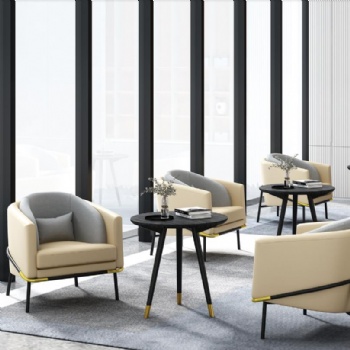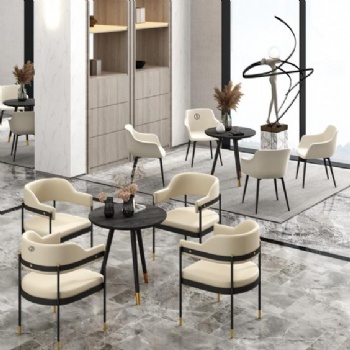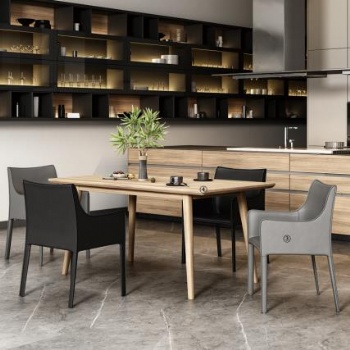News
BASIC KNOWLEDGE OF FURNITURE INDUSTRY
1. Classification of furniture companies
Furniture is closely related to people's daily life. It provides us with a comfortable and elegant living environment and outlines a colorful cultural landscape. Only with furniture can we have a clear work rhythm and a romantic and warm living space.
The furniture manufacturing industry is an industry with a long history. Over the past thousands of years, it has experienced countless innovations and revolutions in materials, technology, craftsmanship, and styles. Today, it is becoming increasingly perfect and mature.
The furniture manufacturing industry has the following characteristics:
◆It is labor-intensive and has relatively low technical content;
◆Short product life cycle and fast replacement;
◆Most of them are produced in small batches and multiple varieties;
◆Poor compatibility among various models and high matching requirements;
◆The working environment is relatively poor, with high noise and pollution;
◆There is a relative lack of excellent technical and management talents.
According to product characteristics, we classify furniture manufacturing companies as follows:
(1) Civilian furniture companies
To produce civilian furniture, such as suite series, living room series, kitchen series, etc. There are also those that only produce a certain type or several types of furniture, such as those that specialize in the production of various beds; those that specialize in the production of civilian sofas, etc.
(2) Office furniture companies
Produces various furniture used in offices, such as: various desks, desk chairs, office desks, staff chairs, filing cabinets, etc. There are also companies that produce certain types of office appliances, such as office sofas, screens, file cabinets, etc.
(3) Hotel furniture companies
Produces hotel furniture, such as hotel suite furniture, lobby furniture, conference hall and banquet hall furniture, etc.
(4) Other furniture companies
Such as companies specializing in the production of hair salon furniture; companies specializing in the production of laboratory furniture; companies specializing in the production of park and other outdoor furniture; companies specializing in the production of kitchen furniture; companies specializing in the production of various wooden doors, etc.
In addition to furniture manufacturing, branches involved in wood processing include:
◆Wood products manufacturing companies
Not large furniture, nor ornamental crafts, such as: dining carts, restaurant trays, knife holders, wooden pencil cases, pen holders, document holders, etc.
◆Crafts manufacturing enterprises
For example, jewelry boxes, jewelry boxes, Christmas gifts, etc.
◆Picture frame manufacturer
Including the production of photo frames, picture frames and frame strips.
◆Wooden flooring manufacturers
There are solid wood floors, veneer floors, bamboo floors, etc.
◆Renovation companies
The marginal jobs in the furniture manufacturing industry use a variety of materials including wood, boards, building materials, fabrics, paper, etc., and are most closely integrated with the furniture industry, involving the production of wall-mounted furniture and furniture supporting projects.
◆Wood processing companies
Engaged in the opening, processing and drying of logs, and the processing and drying of veneers.
◆Material manufacturing companies
Mainly engaged in the production of various artificial panels.
◆Veneer panel companies
Perform veneer processing and parquet processing on various man-made boards such as MDF and particleboard.
In addition, we can also classify export-oriented enterprises and domestic-sales enterprises according to different marketing methods of products. Understanding the sales characteristics of enterprises will help us adopt different methods in production management.
The differences between export-oriented enterprises and domestic sales enterprises:
◆In terms of production planning
Export-oriented companies focus on orders to facilitate production scheduling, while domestic sales companies often determine production quantities based on market response; export-oriented companies have strict production planning requirements and must ship goods on time, while domestic sales companies relatively have a certain amount of space. ; Orders from export-oriented enterprises belonging to the same container can only be completed and shipped together at the same time, while for domestic sales, the same batch of orders can be delivered one after another. Therefore, in terms of export sales, we should pay attention to the integrity of production, while in terms of domestic sales, we can break them down individually and pay attention to the order of delivery. For example, in hotel suites, bedside tables should be delivered first to facilitate the installation of power supplies, while desks, armchairs, etc. can be delivered last in the same batch, which is acceptable to ordinary guests without being affected. Another example: the delivery of office furniture in the same office building should follow the delivery principle from high to low in production scheduling, and should not put the cart before the horse.
◆In terms of staffing
Export-oriented enterprises often need to equip foreign language and international trade talents, customs declarers, etc., while domestic sales-oriented enterprises should vigorously strengthen the construction of sales teams and equip them with marketing backbones.
◆In terms of material characteristics
For export-oriented companies, some materials and accessories are provided by customers, so sometimes the delivery time is long. For domestic-selling companies, most of the materials and accessories are domestically produced, making procurement easy, but special attention must be paid to quality.
◆In terms of selection of factory site
Export-oriented enterprises need to consider more about the convenience of shipment (export). Therefore, many manufacturers choose to be near Shenzhen, Dongguan, and Huangpu Port. Domestic sales companies are mostly located in Shunde, Zhongshan and other places, and they pay more attention to the convenience of domestic customers visiting.
◆In terms of product promotion
Export-oriented companies generally do not do domestic advertising, and rarely do foreign advertising themselves, while domestic-selling companies pay great attention to this aspect and generally have larger exhibition halls in their factories.
◆In terms of product quality
The quality requirements of export-oriented enterprises are higher than those of domestic sales enterprises.
◆In terms of production batch size
The export type generally has a larger batch size, while the domestic sales type has a smaller batch size.
2. Furniture product classification
1. furniture of different materials
(1)Solid wood furniture
Solid wood furniture refers to furniture made entirely of solid wood or made of solid wood and thin wood veneer panels. It is characterized by solidity and durability, rich texture, simple elegance, and luxurious style; its disadvantages are that it is relatively bulky, expensive, and low in novelty.
(2) Panel furniture
Panel furniture is made of man-made panels with veneers. Most of them have folding structures and come in a variety of materials. They generally include sticker furniture, Polywood furniture, wax panel furniture, fireproof board furniture, melamine board furniture, etc. Panel furniture is relatively rich in style and affordable.
(3) Metal furniture
Metal furniture is made of metal materials, usually hollow round or square tubes of iron and stainless steel. The surface treatment is often nickel plating, zinc plating, copper plating or baking paint. Metal furniture is generally light, simple and durable, and occupies a place in the furniture group with its unique characteristics.
(4) Bamboo and rattan furniture
Bamboo and rattan furniture is common in the south and has a long history, but it does not seem to have formed a large-scale market at present. This type of furniture also has a tendency to gradually move closer to the art category.
(5) Glass furniture
Most of the glass furniture is combined with metal or wooden materials, with glass as the main body, and is carefully designed in terms of shape, style and pattern, creating a pure and pleasing modern home.
2. Antique furniture and modern furniture:
(1) Antique furniture
Antique furniture is the application of certain techniques to make furniture into ancient furniture from the style, structure to appearance.
It has a look that has been preserved through the erosion of time.
Antique furniture mostly imitates furniture from the Ming Dynasty and Qing Dynasty. In terms of materials, some are made of pure solid wood; some are made of artificial board veneer materials, and even individual parts (such as drawer bottoms, back panels, etc.) are directly made of plywood. . Structurally, there are some that all use tongue and groove structure, without a single nail in the whole piece of furniture; there are also those that incorporate modern craft structures or adopt the form of disassembly and assembly.
There are two ways to antique antique furniture:
◆Palace style antique
Palace style antique is to imitate the effect of palace furniture, for example, the furniture is often in contact with the human body.
Places such as the back, arms, hands, buttocks, legs, and areas where the feet are placed are sunken and whitened.
◆Country style antique
Country-style antiques imitate the effect of furniture used in the countryside. Due to the poor environment in the countryside,
Therefore, nail holes, knife marks, bruises, burns, exposure to the sun, ant holes, fly droppings, spider webs, etc. can be seen on the furniture.
Antique furniture craftsmanship is unique and complex. For example, painting techniques include: destruction (olding), color rubbing, cloth printing, oxtailing, spraying fly droppings, spraying spider webs, etc. There are also paint flakes, which are cheaper and can reflect antique features.
Antique furniture also pays attention to the consistency of style in terms of accessories. For example, drawers mostly use wooden guide rails, and handles and hardware accessories are made by forging technology, paying attention to the traces of manual work.
(2) Modern furniture
Compared with antique furniture, modern furniture has the following characteristics:
◆The materials used are more diverse;
◆The structure is richer, using more connection keys and can be disassembled and assembled;
◆Become concise and bright in style;
◆The style can be better integrated with the modern environment, pursue harmony and unity with the modern room, be better close to people's lives, and reflect modern aesthetic taste;
◆More flexible in surface treatment and adopting more advanced technologies.
3. Civil furniture, office furniture, hotel furniture, chair furniture
(1) Civil furniture
It is furniture used in residents’ family life, mainly including: suites (beds, bedside tables, wardrobes, dressing tables, makeup stools) writing desks, computer tables, dining tables, dining chairs, coffee tables, tea cabinets, sofas, wine cabinets, and TV cabinets. , base cabinets, etc. The materials used in the production of civilian furniture are the most abundant, the styles are also varied, and the grades are also wider.
(2) Office furniture
It refers to various types of furniture used in offices, mainly including: executive desks, manager desks, staff desks, computer desks, file cabinets, screens, conference desks, conference tables, executive chairs, middle office chairs, staff chairs, sofa series, etc. Factories that produce office furniture should be equipped with installation teams.
(3) Hotel furniture
The production of hotel furniture is often combined with hotel decoration, and some products must be designed and manufactured according to actual conditions. Hotel furniture has its own structure and style characteristics. It often uses exquisite materials and has many carved parts.
(4) Chair furniture
Chair furniture has actually been mentioned scatteredly before. If we analyze them as a category, we can better understand it. Chair furniture includes: dining chairs, class chairs, staff chairs, theater chairs, conference chairs, park chairs, swivel chairs, armchairs, armchairs, soft leather chairs, folding chairs, sofas, etc.
4. Solid wood furniture and panel furniture
(1)Solid wood furniture
Solid wood furniture originally refers to furniture made purely of solid wood, such as birch, beech, catalpa wood, rubber wood, pine, mahogany, etc. But now, in order to reduce costs, some so-called solid wood furniture has actually used more artificial boards (such as MDF, particleboard, plywood) and other materials. Artificial board veneers mostly use beech veneer, shadow veneer, cherry veneer, walnut veneer, etc. with better texture. The structure of solid wood furniture is mainly tongue and groove structure, and the accessories pay attention to luxurious style.
There is a separate series of solid wood furniture - mahogany furniture. Mahogany furniture is made of mahogany (such as rosewood, rosewood, rosewood, etc.), with red color, rich carved patterns, simple structure and exquisite materials.
(2) Panel furniture
From the appearance and structure of panel furniture, all parts are composed of panels, with "boards" replacing components such as "columns" and "feet". There are two types of boards to choose from. One type does not require painting and has a good veneer; the other type needs to be painted again. The former is like fireproof board and Polyboard; the latter is like sticker furniture.
There are two production forms of panel furniture: one is the disassembly type, which has higher requirements on materials.
Each board must be edge-sealed, drilled, and connected by connecting keys, mainly MDF and particleboard; the other is the prefabricated type, which mostly uses cheap materials, and is first nailed into a whole, and then batched. Dusting, polishing, and stickers often do not require connecting keys, and the cost is low.
Among panel furniture with stickers, the grade of MDF materials is relatively high. Some use hollow aluminum alloy materials in the door panel position, which is both lightweight and prevents deformation, and has better effects.
Melamine boards are mostly used to produce office desks, while fireproof boards are mostly used to produce office desks and kitchen cabinets. When using this type of material, there are fewer processing steps and the process is simple.
(3) Different characteristics in the production of solid wood furniture and panel furniture
◆The production process of solid wood furniture is complex and the cycle is long; the production process of panel furniture is simple and the cycle is short.
◆The unique processes of solid wood furniture are wood treatment, flat planing, and blank sanding; the unique processes of panel furniture are edge sealing, hot and cold pressing, and stickers (veneer).
◆In the production of solid wood furniture, attention should be paid to the comprehensive utilization of wood; in the production of panel furniture, attention should be paid to the cutting design of the boards.
◆To achieve the same output value, the production of solid wood products requires one-third to one-half more equipment, space, and personnel than the production of panel products, but the profits of solid wood products are also relatively high.
◆To improve the quality of solid wood products, we should start from the drying of the wood at the beginning and carry out comprehensive control throughout the entire processing process until the later repairing and polishing processes. For plate products, more attention should be paid to the accuracy of hole positions.
Categories
Contact Us
- 0086 139 23119482
- info@etengfurniture.com
- +86-13923119482



